









96
MAGNIFICENT OBSESSION
How one woman’s love of Russian art gave Richmond exclusive masterpieces
By Rachel Kester










How one woman’s love of Russian art gave Richmond exclusive masterpieces
By Rachel Kester102
WEEDED OUT
Virginia clamps down on its burgeoning cannabis economy
 By Don Harrison
By Don Harrison
108
Exploring the annual feast of locally grown food, including farmers market faves, heirloom crops and more
By Bird Cox, Stephanie Ganz, Eileen Mellon and Genevelyn Steele




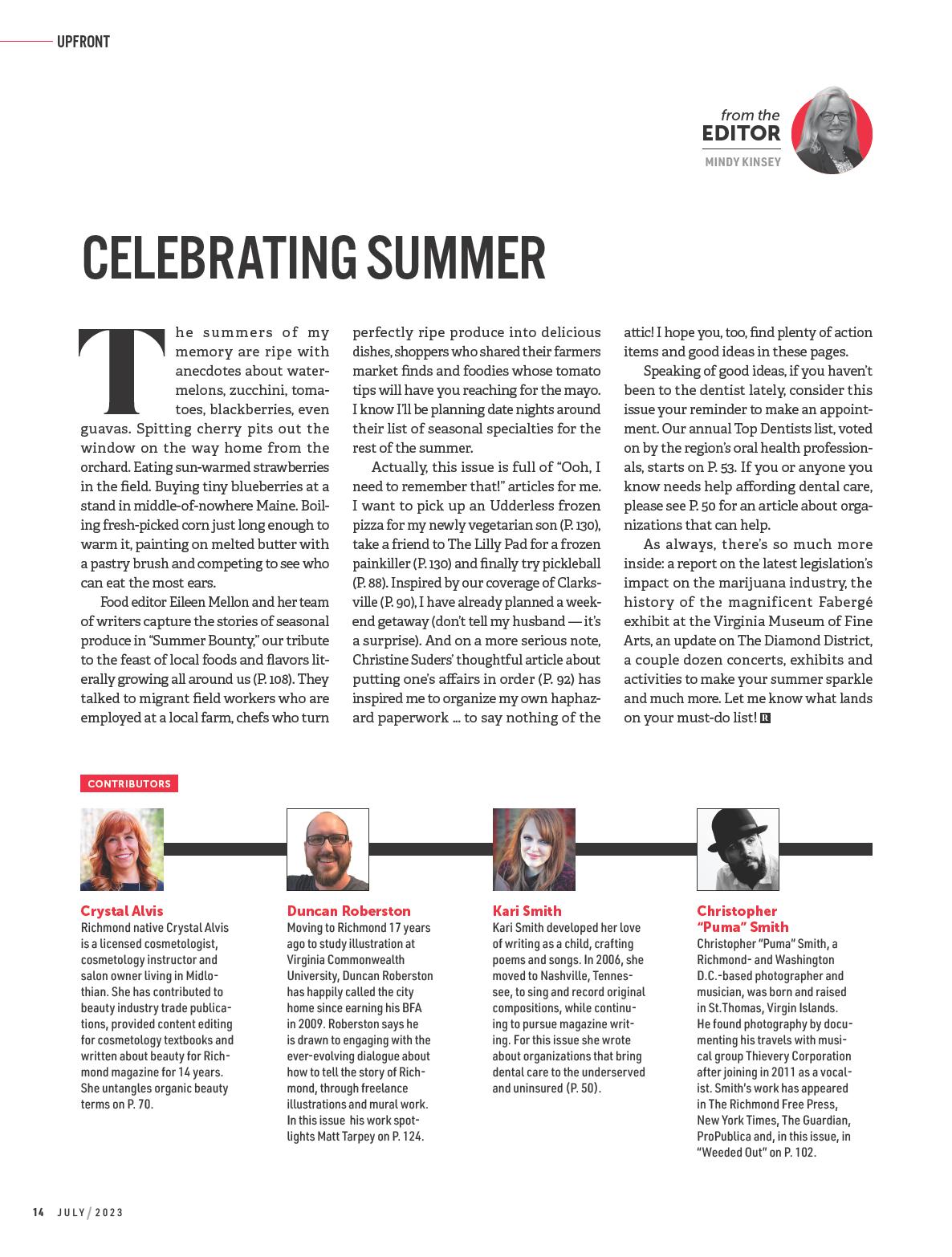





A fatal shooting sparks a new law that allows seniors to graduate posthumously
AThomas Jefferson High School student killed in 2021 can receive a high school diploma thanks to a new law.
Daveon Ellio was 18 years old when he was shot on Nov. 11, 2021, in the Westover neighborhood of south Richmond. An arrest has not been made as of May 2023, according to Richmond police.
In March 2022, friends and family protested outside his high school, calling, among other things, for him to be awarded a posthumous diploma. At the time, the school division was unable to grant an exception to state graduation requirements, so a certification of completion was o ered instead.

“A lot of kids look up to him; they look forward to seeing him when he comes to school,” his mother, Miche Crumm, told NBC12. “… I want justice. I want a diploma, and I want this to stop.”
As of July 1, Ellio can now receive his diploma. e General Assembly unanimously passed HB 1514, introduced by Del.
A NEW LAW ALLOWS WEBSITES to be held civilly liable for exposing minors to pornographic material and not verifying that consumers are adults.
SB 1515, signed by Gov. Glenn Youngkin in May and set to go in effect July 1, requires any commercial entity to verify the age and identity of a user before they can access its content if more than a third of it constitutes “material harmful to minors.” That material is defined as “any description or representation of nudity, sexual conduct, sexual excitement or sadomasochistic abuse” that is "lacking

Dawn Adams, D-Richmond. e legislation allows the Board of Education to waive graduation requirements and award a high school diploma on a case-by-case basis. A parent of the student must request the waiver, and the student must have been in good standing during their senior year.
“I felt that allowing for posthumous diplomas would be a small but significant gesture that honors a deceased student's final journey and o ers solace and closure to grieving families,” Adams says. “I would hope that the Board of Education waives the requirements for any deceased student who is eligible under the bill should their family request a diploma. I know of several families that will take advantage of the new law.” —
in serious literary, artistic, political or scientific value for minors.”
The Senate rejected a version of the bill by Youngkin that would have also required verifiable parental consent, largely for the stated purpose of data collection protection. “While I am disappointed my recommendations to ... provide protections for minors on social media were rejected, I'm committed to pursuing [this issue] next year,” the governor said in a statement on the bill’s signing.
Youngkin and the bill’s sponsor, Sen. Bill Stanley, R-Franklin County, did not respond to requests for comment.
A similar law in Utah spurred Pornhub in May to disable access within the state rather than implement a verification system, and a legal challenge has been filed by
Mark Newtonthe Free Speech Coalition, an adult entertainment trade organization. In March, the group sent a letter to Youngkin, stating that the bill was unconstitutional and would ultimately be ineffective in solving the problem of safeguarding minors. “We fear that consumers will at best simply evade the measures, or at worst fall prey to criminals eager to rob and extort them,” Executive Director Alison Boden wrote.
“SB 1515 has the same privacy dangers as the Utah legislation, and the same constitutional problems,” says Mike Stabile, a spokesperson for Free Speech Coalition. “No matter what your politics, everyone should be concerned about governmental attempts to patrol our browsers or limit what legal content we consume in the privacy of our own homes.” — MN





























lthough some consider dental care optional, oral health has an important connection to overall health.
Ignoring it opens the door to larger problems. Poor oral health can lead to tooth and gum disease and contribute to conditions such as cardiovascular disease or endocarditis, pregnancy and birth complications, and pneumonia, according to the Mayo Clinic. Conversely, many diseases and conditions can negatively impact dental health, including diabetes, eating disorders, some cancers, HIV/AIDS, Alzheimer’s disease and osteoporosis.
Even knowing the importance, many people face barriers to accessing proper dental care that mean they will continue to su er pain and discomfort associated with dental problems.
More than 747,000 Virginia residents under the age of 65 — including children, students, undocumented, homeless or disabled Virginians — have no health insurance or access to proper dental care, according to the Virginia Dental Association.
Several options for underserved Richmond-area residents exist to address that gap in care, each with individualized resources, specialties and demographic focus. Still, there is always a need for more, says Julie Bilodeau, CEO of CrossOver Healthcare Ministry, one of a handful of providers of dental care to Richmond’s underserved populations. “We need more commu-
nity support. We need extra sets of hands, donations, volunteers,” she says. “If patients don’t come here, they’re either going to an emergency room or they’re going to let the problem get worse.”
Based on data from the National Survey of Children’s Health, the Virginia Dental Association reported that tooth decay and cavities in children were up an estimated 44% in Virginia from 2018-2019 to 2020-2021, due largely to lack of dental care during the COVID-19 pandemic.
A Virginia Health Catalyst survey reported that 27% of children aged 1 to 2 years and 59% of children and young adults aged 3 to 20 years have had preventative dental visits through Medicaid. “It is recommended to visit a dentist around a child’s first birthday and to have regular checkup visits every six months,” says Dr. Jayakumar Jayaraman, VCU School of Dentistry associate professor of pediatric dentistry.
e VCU Dental Care ’s pediatric clinic has taken several initiatives to bridge this gap, he says. One such initiative is the clinic’s involvement in the American Dental Association’s annual Give Kids a Smile project each February. At this year’s event, more than $50,000 in dental treatments were provided at no charge to 98 children in underinsured families.

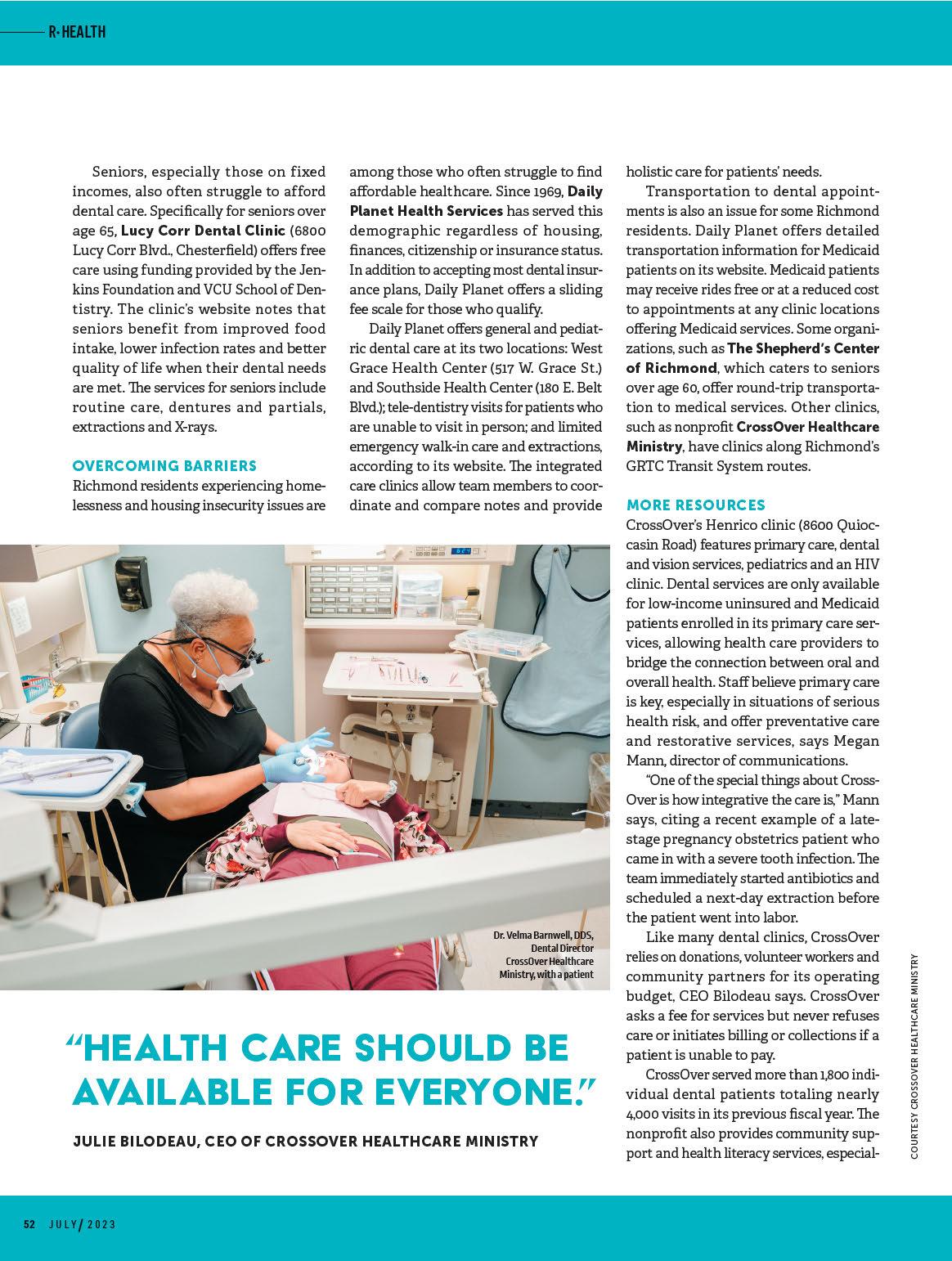
















Richmond area for 46 years. Our doctor-owned practice includes 16 locations and over 60 general dentists and dental specialists. Virginia Family Dentistry dental specialists include orthodontists, periodontists, prosthodontists, endodontists and pediatric dentists. We’ve grown throughout the years to accommodate the needs of our patients. Virginia Family Dentistry aims to provide lifelong patients with the most comprehensive dental care possible — all in one practice. We’re a family of more than 400 dental professionals and sta members who serve generations of families throughout Central Virginia. It’s as simple as that. Visit vadentist.com.
For over 40 years, the goal at VOFS has always been simple — to bring excellence in oral and maxillofacial surgery to the greater Richmond community. Drs. Keeney, Harris, Dymon, Wlodawsky, Watson, Agnihotri, Wheeler, Phelps, Herrera and Gardner are dedicated to patient safety, predictable outcomes and great communication. Procedures range from dental implants to facelifts, wisdom teeth to bone grafts, and everything in between. All of the doctors here are committed to their profession and truly love what they do. Visit oralfacialsurgery.com.
Archstone Counseling and Treatment provides an Intensive Outpatient Program for substance use
disorders. We also serve individuals who are struggling with trauma and complex behavioral health issues. We set ourselves apart with a nonjudgmental atmosphere and a priority of safety and comfort for each client. Whether it’s grief, trauma, mental health or addictions, we can help you build a foundation for your life. Call 804-288-1788 or visit archstonecounseling.com
Executive Health Group has been a leader in concierge medicine for over 20 years. Dr. J. Rand Baggesen and Dr. Jonathan Schaaf designed a cutting-edge precision health care program, utilizing world class technologies with a ve-star experience. At EHG, we scan you inside and out and use the latest laboratories available to not only detect possible risks but to provide a benchmark for the future. Your exam is intended to detect and prevent — not just manage — disease. Our elite physicians know you are busy and will respect your time, making themselves as exible as possible to ensure that you receive the most thorough care available. Call 804-560-3295 or visit executive.md
Dr. Neil J. Zemmel founded Richmond Aesthetic Surgery in July 2007. After practicing in South Beach, Fla., for several years, Dr. Zemmel has returned to Richmond and brings the latest minimally invasive breast, body and facial-rejuvenation procedures to the area. Dr. Zemmel also performs many reconstructive
procedures of the head, neck, body, hand and breast. Dr. Zemmel graduated from the College of William and Mary with a degree in chemistry and obtained his medical degree at the University of Virginia. He then completed the competitive six-year integrated plastic and reconstructive training program at Virginia Commonwealth University Medical Center. Dr. Zemmel is a board-certied plastic surgeon, and he is dedicated to providing the highest level of patient care on a very personal level. Call 804-423-2100 or visit richmondplasticsurgery.com
Virginia Urology has over 40 board-certi ed providers and is one of the largest urology practices in the United States. Their physicians specialize in urology, urogynecology, urologic pathology, urologic radiology and radiation oncology. Many providers sub-specialize even further within the urologic eld in areas such as oncology, incontinence, minimally invasive techniques, erectile dysfunction, kidney stones and women’s urology. Virginia Urology patients are assured that their physician is knowledgeable and highly experienced. Since treatments are not one size ts all, Virginia Urology provides the area’s most comprehensive range of services in urologic care. 804-3309105 or uro.com
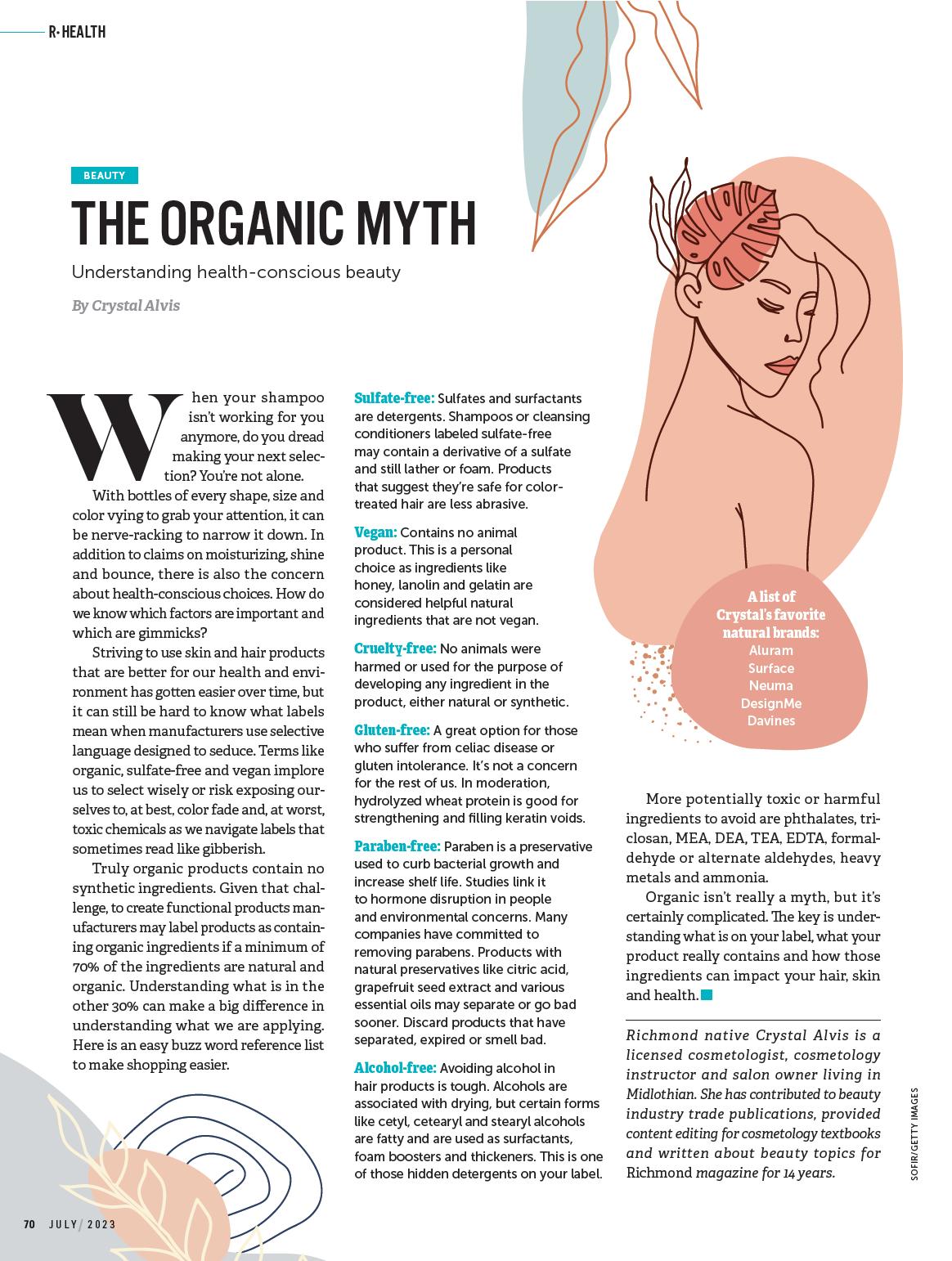















For 75 years, Ellman’s Dance Boutique has been an institution in Richmond’s dance community. Its third owner, Rosemary Liberto, says she

is proud to continue Ellman’s legacy of personalized service.
e Pa erson Avenue boutique has its roots in a general shoe store founded in 1948 in Carytown by John and Ida Ellman. Based on customers’ requests, dance shoes and apparel were later added to its inventory. In 1980, the Ellmans retired and sold the business to a friend, Jo Anne Wade Draucker, who further expanded the dance merchandise and moved the boutique to West Cary Street.
It was at this location that Liberto, then a high school student, began working her first job at the store she had been visiting as a dancer since she was a li le girl. She continued working at Ellman’s during high school and college, eventu-
Brittany DeRaffele, owner of local jewelry brand Sun & Selene, and Jacqueline Carrington, founder of People of Color nail polishes, connected through a mutual customer on Instagram and hit it off. DeRaffele’s jewelry uses recycled metals and responsibly sourced gemstones. Meanwhile, Carrington aims to honor and portray people of color through her nail polish collections and the narratives they tell. Together, they created Birthstone Bundles, a collection of handcrafted gemstone rings paired with nontoxic nail polishes. Bundles range from $140-$195 with rings in sizes 6, 7 and 8. sunandselene.com —KB
ally becoming store manager. She le to work in the fitness industry but returned to Richmond in 2001 to resume her position at Ellman’s. In 2016, she bought the store from Draucker. Ellman’s moved and reopened in January 2022 at 8524 Pa erson Ave. in Beverly Hills Shopping Center.
Liberto’s favorite part of the job is pointe shoe fittings, where she seeks to ensure that each customer is fitted properly to prevent injuries and improve performance. Dedication to one-on-one attention is what sets Ellman’s Dance Boutique apart, Liberto says. “It takes a long time to learn how to fit pointe shoes properly, but it’s worth it to see the satisfaction on a customer’s face when they find the perfect fit.”

Ellman’s has introduced e-commerce to its website (ellmansdancewear.com), but “the in-person customer experience remains unchanged,” Liberto says. Customers receive the personalized a ention Ellman’s is known for even if they place an order online for pickup.
e boutique will mark its 75th anniversary with promotions and sales for customers. Liberto says she is developing plans for a celebration later this year. “Ellman’s Dance Boutique is more than just a store,” she says. “It’s a place where dancers can find the perfect shoes and dance a ire while receiving personalized attention from experienced professionals.” R
Fashion designer Travian Vann relocated her business from Hampton to Stony Point Fashion Park to make travel easier for her clients in Virginia, Maryland and Washington, D.C.

As part of making custom-designed clothing for special occasions, Vann relishes creating “second looks” for brides to wear following their wedding gowns, offering unique, tailored designs. She takes pride in consultations that create one-on-one experiences for clients.
“All of my designs are made with you in mind. If you can imagine it, we can design it,” Vann says. travianvann.com —KB



When the John H. Kerr Dam was completed along the Roanoke River in southern Virginia in 1952, it provided much-needed flood relief, became a reliable source of energy for the region and created the state’s only lakeside town: Clarksville.
The reservoir — known to local residents as Buggs Island Lake — submerged Clarksville’s First Street, which ran along the river’s edge. Downtown, which now starts at Second Street and extends to Ninth Street, is easily traversed on foot if you arrive via watercraft, which can be moored for free at the town dock. While the lake’s 800 miles of shoreline command attention, there are plenty of other ways to spend your time in what Clarksville Town Manager Je Jones calls “a hidden charmer” of a place (visitmeckva.com/towns/clarksville)
Traveling down Virginia Avenue, the town’s main drag, newcomers might first notice the empty storefronts, which town leaders are working to fill. But a bevy of locally owned shops o er a range of gifts, home decor and apparel.
In Grandfather’s Country Creations, seek out the Richmond Times-Dispatch front pages — used as wallpaper — chronicling JFK’s assassination and Nixon’s resignation. The Corner at Two One Six, a specialty food, gift and art store, might have
the widest price range in town: $3 to $878, according to co-owner Carol Dunn. Hite’s Clothing is where you’ll find Lake Life merchandise as well as that item you forgot to pack. Owner Heather Hite, who took over the business founded by two uncles, moves easily between helping a parent source flip-flops for a forgetful child and fitting teenagers in prom tuxedos.
For the game lover, Baldwin House Hobbies, opened this spring by Tim and Leila Baldwin, carries remote-controlled
cars, boats and planes as well as tabletop games. Visitors are welcome to drop in, and regular game nights and tournaments keep the store open well past the 5 p.m. closing time of most downtown businesses.

There are several ways to enjoy an overnight stay downtown. The Delicate Flower Bed & Breakfast, a long-vacant 19th-century home, has been transformed into a welcoming escape with spacious flower-themed rooms and inviting public spaces, including a plush parlor and front porch.
Just a block away is Cooper’s Landing Inn & Traveler’s Tavern, with suites in the main house as well as six private cottages, perfect for a private getaway or group excursion. Amenities include an in-ground pool, fire pit, gazebo and hot tub inside a renovated smokehouse. Cooper’s Landing also o ers fine dining on the house’s first floor under a wisteria-entwined pergola.
A short drive down the road is The Sunnyside Sisters Bed and Breakfast, owned by a couple who moved to the area from the Netherlands. They carried out a renovation during the pandemic, naming guest rooms for the sisters who ran a school for girls in the house in the late 19th century.
Two recently renovated Choice Hotels — Clarion Pointe and Quality Inn — also hug the waterfront.
Occoneechee State Park, across the lake from downtown, is a one-stop shop for outdoor activity. Hikers, bikers and horseback riders have miles of trails; the privately managed Clarksville Water










Constructed in 1903, the Imperial Peter the Great Easter Egg is made of gold, silver-gilt, diamonds, rubies, enamel, rock crystal, sapphire and watercolor paintings on ivory. It was completed to celebrate the 200th anniversary of Peter the Great’s founding of St. Petersburg. Portraits of Peter the Great and Nicholas II are featured on the exterior, alongside Peter the Great’s log hut and Nicholas II’s Winter Palace. The piece opens to reveal a copy of Étienne Maurice Falconet’s Bronze Horseman, a statue of Peter the Great that stands in Senate Square in St. Petersburg. Fabergé firm (Russian, 1 4 -1917), Vasilii uiev (Russian, 1 70-after 19 1) painter, Mi hail Per hin (Russian, 1 0-190 ) or master. ©Virginia Museum of Fine Arts, Be uest of illian Thomas Pratt, 47. 0.

Exhibit at the Hammer Galleries. roughout the 1930s and ’40s, Pra and other collectors competed to find and buy works by Fabergé. By collaborating with dealers Alexander and Ray Schaffer, Pra maximized her budget — and her Fabergé collection.
At the time of her death in 1947, Pra was residing at Chatham Manor in Fredericksburg. She bequeathed her collection of Fabergé and Russian decorative arts to the VMFA “because VMFA was the largest art museum in the state of Virginia,” explains Shifman.
e museum didn’t immediately display the collection, which by then numbered more than 400 items. e five Imperial eggs made a quick appearance each Easter, but it wasn’t until 1954 that the VMFA created a permanent Fabergé exhibit; it has since become one of the most popular galleries.
While the eggs are beautiful to behold, it’s their interiors that inspire the most interest. Many are known for hidden surprises, like the multiple frames nestled inside the Red Cross Egg, but some display their magical mechanisms, such as the tiny paintings adorning the Egg with Revolving Miniatures. And, of course, apart from their cra smanship and quirky mechanisms, the eggs’ histories are compelling as well.
e oldest egg in the VMFA collection, the Easter Egg with Revolving Miniatures, or Rock Crystal Egg, was a gift from Czar Nicholas II to his wife, Alexandra Feodorovna, two months before his coronation. e deep blue Tsarevich Egg, also a gi from Nicholas II to his wife, opens to reveal a portrait of their only son, Alexei. He presented her with the Peter the Great Egg in 1903 to celebrate the 200th anniversary of St. Petersburg’s founding. It displays both Peter the Great and Nicholas II and their favorite lodgings on its exterior and opens to reveal a tiny replica of Falconet’s Peter the Great statue.
Nicholas II presented the Pelican Egg to his mother, Maria Feodorovna, to celebrate her charity work (the pelican is a symbol of charity). Decades later, he presented her with the Red Cross Egg with Portraits to honor her work as the head of the Russian Red Cross and to commemorate the e orts of his wife, sister, cousin and daughters during World War I.
While much is known about the eggs and their backgrounds, they still have their secrets. For instance, one of the painted scenes in the Easter Egg with Revolving Miniatures was misidentified until recently. Shifman says
the miniature was thought to portray a church in Darmstadt, Germany, but was determined to show a bed and breakfast hotel in Harrogate, England, where Alexandra had stayed before she married Nicholas II.
e VMFA Conservation Department tends the eggs to ensure they last for generations. Ainslie Harrison, the Conservator and Head of Sculpture and Decorative Arts Conservation, explains that while major preservation treatments took place decades ago, the five Imperial eggs still require regular care. “ e materials range from gemstones and semiprecious stones, gold and silver to watercolor on ivory and enamel,” she says. “Most of these materials, such as the precious metals and stones, are very high quality and hold up well without frequent intervention. Some of the metal components, however, do require periodic polishing to reduce tarnish that develops over time and causes the metals to appear darker or more reddish or purple in color.” Gentle techniques and specialized equipment, such as micro swabs and microcrystalline wax, as well as the use of low lighting in the gallery, help keep these fragile materials in exquisite condition.
According to Harrison, the eggs are monitored by gallery associates and the gallery care team, who report problems, like flaking enamel or loose stones, to the conservation department. eir treatment is documented in detailed photos and wri en reports.
e eggs are challenging to preserve due to their age and materials. Harrison says the Peter the Great egg is the most temperamental. “It includes a spring-loaded mechanism on the inside that originally raised the platform holding the surprise,” she explains. “The mechanism now causes the top and bo om of the egg to spring apart readily when handled or moved.” Conservators handle the piece gingerly to avoid needing to reset the apparatus or damaging the surrounding watercolors painted on ivory and other components.

It takes a lot of work to ensure the eggs retain their glory, but it’s done to preserve artworks that are both intriguing pieces of history and examples of creativity at its finest — as well as to provide museum visitors with an unforge able and uniquely Richmond experience.
“As a jewelry firm, the House of Fabergé is extraordinary,” Shifman says. “ e quality and design of each piece by Fabergé is beautiful and worthy of high regard. Anyone who cares about beauty and quality of execution should admire Fabergé objects.” R

Graham Redfern’s business will be considered all but illegal in Virginia starting July 1, and he has no idea what he’s going to do about it.
“I guess I’ll have to go to North Carolina,” says the owner of Redfern Market, a 10employee hemp nursery and retail store in Caroline County. “We sell everything from dog treats to creams to gummies and chocolates. We have an array of products for different purposes, many for medicinal and wellness purposes, but 90% will have to be gone.”

This is no fly-by-night operator. Before he started his marijuana-focused market, Redfern was integral in se ing up a state research program with the University of Virginia, Virginia




Tech, Virginia State University and James Madison University on growing hemp. “You can consume cannabis in Virginia now,” he says, shaking his head, “but you can’t buy it. That’s crazy.”

Redfern joins a bevy of mostly shell-shocked business owners across the commonwealth who invested in Virginia’s burgeoning hemp industry before and a er cannabis was officially legalized in 2021. Now, thanks to state laws that go into effect this month, many say they are facing a doomsday scenario.
“They are trying to scare us and shut the industry down,” says Jason Amatucci of the Virginia Hemp Coalition, a longestablished marijuana advocacy organization. “A lot of businesses are telling me that they’ve had enough, why operate in a state that treats you like trash?”




In the absence of a regulated marketplace, the only legal way to buy pot in Virginia is to join the commonwealth’s medical marijuana program and obtain wri en certification from a medical doctor.
“It’s set up now as a pay-to-play recreational system,” says Redfern. “Now you can have an 18-year-old high school kid call a telehealth doctor and say they have anxiety, and in an hour they can walk into a legal dispensary and buy an ounce of weed. And yet you have to be 21 to buy my hemp dog treats.”
“Essentially, they found a way to ban marijuana without calling it a ban,” says Yan Gleyzer, the owner of VGI, a distributor of CBD products and vape items, and Chesterfield Hemp Company, a manufacturing company. He also owns four Vape Guys stores in the region. “The medical monopolies are behind it. And there’s nothing better than having the government ban your competition for you.”
He and others point to Adams, the Virginia delegate who is also a nurse practitioner and the owner of RVA Telecare, as a member of the General Assembly who who could be seen as benefiting from the recent legislation. Through her business, for example, a consultation for a medical marijuana card costs more than $150 per patient and is not covered by insurance. According to her biography on the RVA Telecare website, “[Adams] takes an integrative approach to health care focusing on the mind-body-spirit connection while treating medical conditions that includes the support of medical cannabis.”
“There is nothing in any of the medical cannabis laws that would directly benefit me that would not globally affect other medical providers,” says Adams. “Just because you have expertise in something doesn’t make you have a conflict.”
Adams says that she is for a regulated market for cannabis and hemp. “I support the parts of the law that close loopholes related to unregulated intoxicants; however, there are still loopholes, and it would have been safer to regulate products similarly to the medical cannabis program.”
As for the question of whether the new laws create a monopoly for the companies who are legally in that program, she says, “Not really. [They] have, like the hemp industry, leveraged people’s lack of understanding for their own gain. All of these products need regulation … .”
In lieu of a recreational marketplace, most people will not utilize medical marijuana, Gleyzer argues — they will patronize the black market. “There’s no lab testing with the black market. The law will destroy jobs, and that includes farming jobs. But the black market will thrive.” (Adams admits that a rise in illegal sales is “absolutely possible.”)
But Adams challenges the view that the new laws create a monopoly for the medical marijuana firms. “They didn’t push
hard around the hemp laws. There is a great deal of misunderstanding about this and it’s unfortunate.”
According to the Virginia Public Access Project, the Florida-based Jushi Holdings sent contributions to more lawmakers than any other single donor ahead of this year’s legislative session. The house bill’s sponsor, Kilgore, has been criticized for taking $22,000 in campaign dollars from Jushi, which is one of the publicly traded out-of-state companies, along with Cresco Labs and Green Thumb, currently licensed to sell medical marijuana in Virginia in a program regulated through the Virginia Board of Pharmacy.

“We believe these measures illustrate the continued importance of the medical cannabis program in the Commonwealth,” Jushi said in a statement about Virginia’s new laws.
Derek Wall, the owner of Buffalo Hemp Company in Floyd and the secretary of the VAC, thinks that Virginia’s new pot laws will see a bevy of lawsuits. “There are a lot of people who believe, because it’s inconsistent with the federal farm bill, affects interstate commerce, unwinds existing contracts people have and makes illegal industries that people have spent millions investing in, that this underlying bill will be challenged in court. That’s not our group’s position, but it’s just another thing to keep in mind. All they are trying to do is turn people into criminals.”
VGI’s Yan Gleyzer is slated to move Chesterfield Hemp Company, his manufacturing operation, to Roanoke Rapids, North Carolina, “just across the border. My Vape Guys stores will stay here because we sell other products as well.” Angered by the new laws, he’s throwing his hat into the ring to run as a Republican challenger for Virginia’s redrawn 73rd District, which represents portions of Chesterfield.
“Virginia has become a state unfriendly to business,” he says. “There has to be a change. These lawmakers, their minds are still stuck in the 1960s.” R
 Produce from Amy's Garden
Produce from Amy's Garden

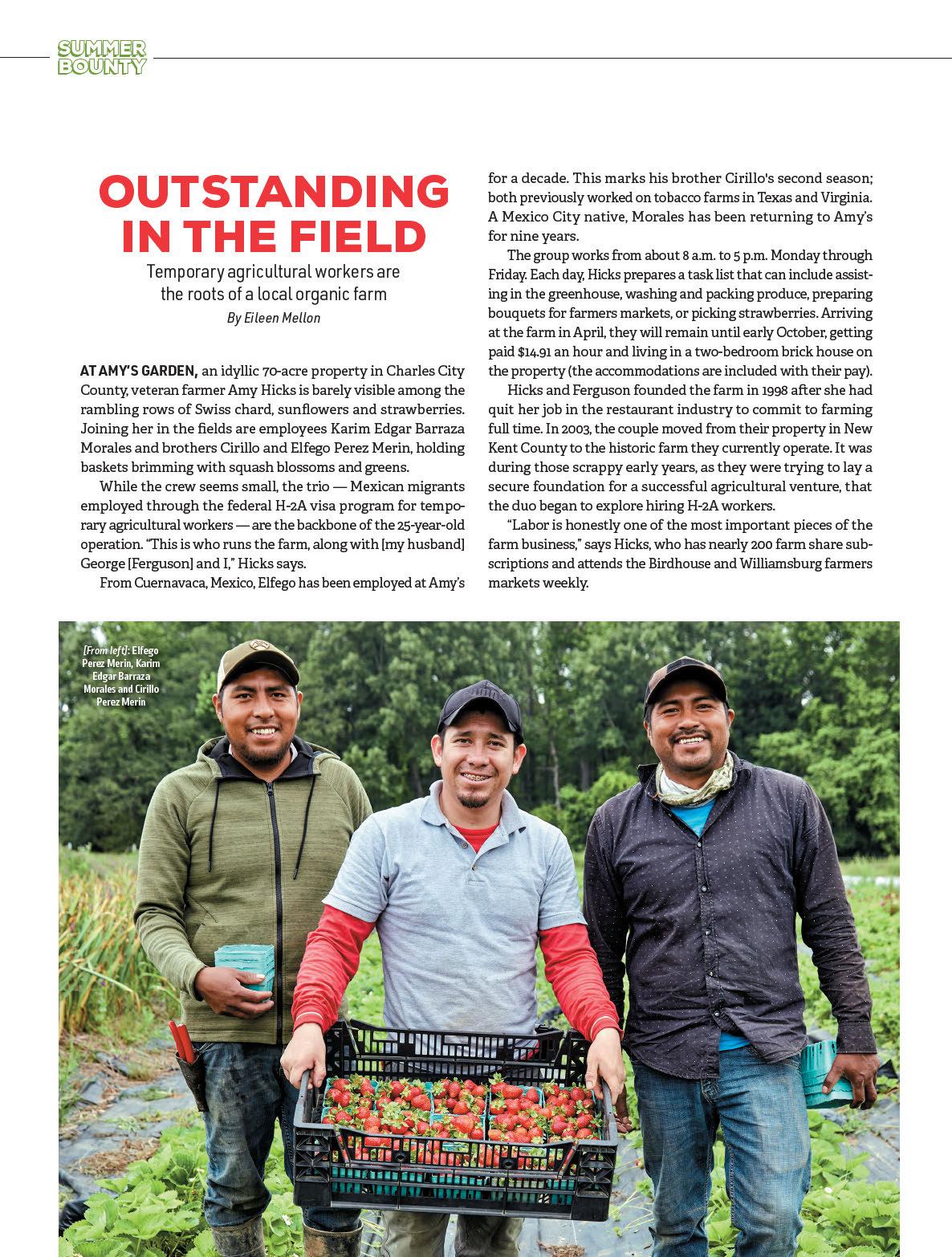
Unlike farms that operate all year, Amy’s Garden has adopted a six-months-on, six-months-off method, making it even more difficult to establish a steady crew of workers who want to come back each growing season.

“It is a seasonal job … it’s hard to get a good returning work force, so that was the goal [with using H-2A workers], to have a trained, returning workforce, and it’s been amazing,” Hicks says. “It’s completely changed the trajectory of the farm; it’s made it so much be er.”
In the United States, employers can hire migrants to fill temporary agricultural jobs for up to 10 months of the year. According to the United States Department of Agriculture, immigrant farmworkers make up an estimated 74% of agriculture workers. In 2022, the U.S. Department of Labor reported that there were nearly 370,000 temporary jobs filled under the program.
But while the workers at Amy’s Garden, all in their early 30s, initially came to the United States with hopes of establishing economic security and a be er future for themselves and their families, the decision to repeatedly relocate to a different country for work has also had its drawbacks.
Being separated from their families takes a toll, and all three express that they deeply miss their partners, children and/or Mexico. When asked how o en they talk to their loved ones, they all respond, “Every day.”
“It’s really hard, and there’s a lot of things you’re losing out on because you’re here and not there,” says Morales in Spanish. Married for 16 years, he is currently in the process of separating from his wife. He says the distance has been incredibly taxing on their relationship, especially a er his wife had a miscarriage. Unable to devote the time and space to fully process the separation, he says he feels as if everything he has established by coming to the U.S., from making money to buying a house, has been destroyed.
Playing an integral part in the farm’s success and growth over the past decade, Morales made the difficult decision to head
back to Mexico one week a er my initial visit this spring. He says that while financial stability is what originally brought him to America, he is now in search of emotional stability and healing.
Hicks, who has been employing H-2A visa workers since 2007, is familiar with the emotions that can arise when working a seasonal job. While Morales’ departure will undoubtedly make for a tough transition on the farm, especially during peak produce season, Cirillo and Elfego have recommended a friend who will arrive in a month to fill his position, and Hicks says she understands and respects his choice.
“This happens, he’s been here 10 years almost; it’s hard being away from their families, so we experience that throughout the years, and we talk about it,” she says. “The thing is, you have to be happy here, and if you’re not, we do something else ... but that’s OK, you want your workforce to be happy, that’s the most important thing.”
Cirillo has four kids ranging in age from 2 to 11. He says that he enjoys farming and that when he’s outside with his hands in the dirt his worries seem to dissipate. A er working on a tobacco farm in Texas and clocking 18-hour days, he prefers the environment at Amy’s Garden, describing it as much more peaceful.
Although Cirillo longs for his family, he says working alongside his brother has provided them both with a support system and helps them feel less disconnected from their life in Mexico. “We’re here for each other,” he says in Spanish.
One of Hicks’ longest-tenured workers to date, Elfego says he returns to the farm because he likes being there, feels appropriately compensated and, compared to other jobs he’s held, it’s not as physically grueling. He adds that he would encourage others who are looking for similar opportunities to apply.
With a 6-month-old at home, however, Elfego’s absence affects his partner even more. “She feels lonely because, obviously, I’m here,” he says in Spanish.
Locally, Amy’s Garden is one of the only organic produce farms that relies on H-2A workers, Hicks says. She shares that she has connected online with other agricultural businesses that use H-2A to gain insight, ask questions and share experiences.
“A lot of times I’ll reach out, because it is a unique program with unique situations and predicaments,” she says. “It’s hard; it’s not for everyone to be away from their family. The upside is that hopefully they’re earning a wage here that is not a ainable in Mexico and hopefully it’s helping them to at least build their life there in a way they wouldn't be able to. … In a way, it’s a sucky situation, but it is a good opportunity for them. It’s a complicated issue, but it’s a great program for farmers, I think, and it’s really made us grow the business.”

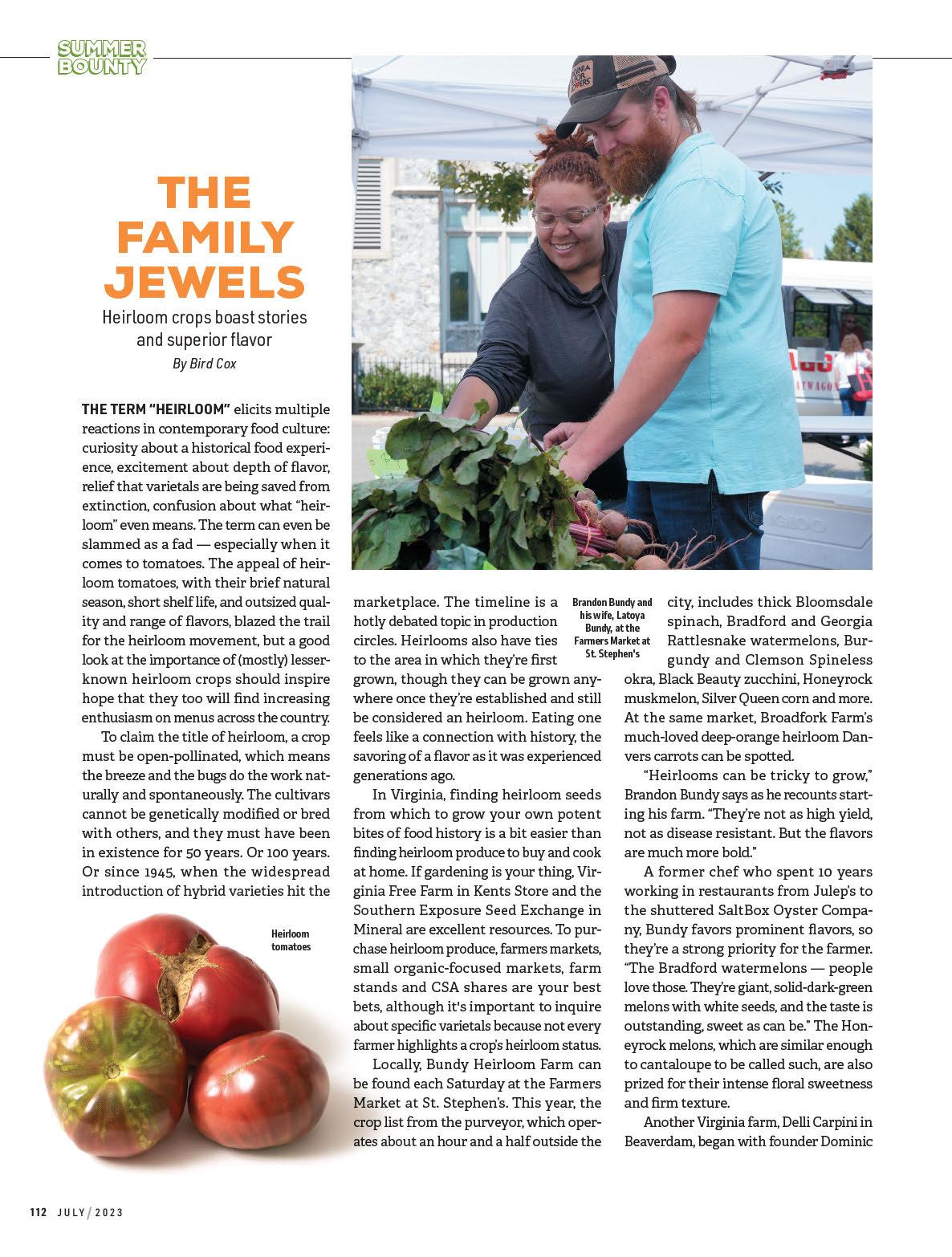







Ask Kellie Hughes Jordan about ferments, and she gets almost giddy with excitement. Jordan, manager a nd master brewer for Owl Spoon Water Kefir, declares the product she cra s to be kombucha’s cooler cousin and the gut-healthy, unprocessed probiotic the beverage of the future.
“Lot of ferments are pre y funky and an acquired taste; this doesn’t have that,” says Jordan, a former kraut maker and kombucha brewer before joining Owl Spoon two years ago. “Water kefir is a gateway drug to introducing people to a [healthier] lifestyle of having more fermented foods in their diet. I always say, you don’t have to hold the counter while you’re drinking it, no pep talk involved. I call it a fizzy, probiotic soda.”
When we think of drinkable ferments, kombucha often comes to mind. The beverage has become a mainstream gut-healthy drink of choice; it’s readily available, and there’s even boozy spiked versions on the market as well. Another option is dairy kefir, the slightly sour, tangy, fermented drinkable yogurt. But while ferments are o en marked by their cheek-puckering qualities or acidic notes, water kefir is di erent.
“It’s a probiotic that doesn’t taste like a funky fermented drink; it’s pretty straightforward,” Owl Spoon Water Kefir founder Jay McGee says. “Kombucha has taken up the entire category of fermented probiotic beverages. It’s taken up all our brain space.”
Recently, Owl Spoon has been gaining momentum and a racting an audience
with its more subtle, but equally potent, probiotic benefits. While Jordan may be considered the fermentation authority behind the operation, McGee is the health-forward leader with a fascination for food history. With a background in linguistics and anthropology, he views ferments as a timeless, cross-cultural culinary tradition.
“The human experience has always [included] fermented stu , the foundation of cultures everywhere for all time,” McGee says. “I kind of got really into the thought of ‘Here’s this thing that helps me feel more human.’ What a human thing to do, to drink fermented stu .”
A few years ago, when looking to introduce a healthy beverage to his kids, McGee began experimenting with making

kefir in his kitchen. “I was making water kefir at home, mostly for my kids, and wanting a good immunity booster and a drink that wasn’t sugary but was fun,” he says. “ en it became [something I made for] friends, then I was throwing a cooler on my front porch and people were slipping a $5 bill under the mat.”
In 2019, McGee launched Owl Spoon Water Kefir. Brewed with organic ingredients, flavors range from hibiscus-tea to the bestselling tangerine-mango. E ervescent with a smidge of sweetness, the fermented water is chock-full of living cultures, enzymes and electrolytes.
Although water kefir is on the rise, Jordan and McGee still say they spend many of their face-to-face interactions at local markets explaining the power of

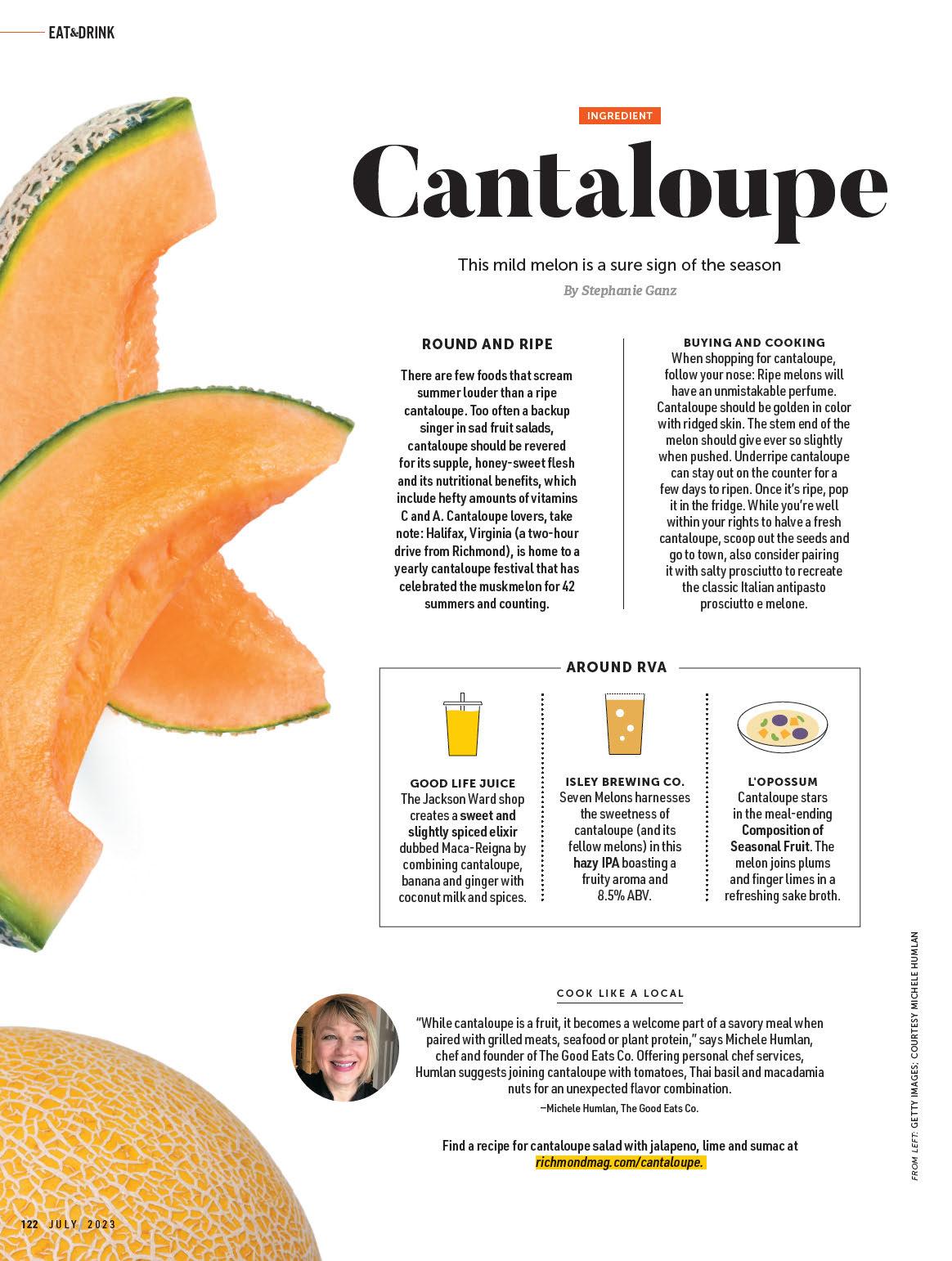



When David Hunsaker and his wife, Barbara, get on the subject of tomatoes, you’d better get comfortable, especially if they’ve enjoyed a glass or two of sparkling rosé. Known locally as the tomato king and queen, the vivacious duo and enthusiastic leaders of Village Garden farm over 300 varieties of the fruit on their small farm in Hanover that boasts a tomato-friendly terroir — a trifecta of clay, dirt and sand.
For the past two years, the couple, along with enthusiastic oenophile and sommelier Jason Tesauro of Barboursville Vineyards, have been calling upon top chefs and food and beverage professionals across the state to elevate the humble tomato through the Summer Supper Somm dinner series. And in 2023, the ambitious ambassadors of the commonwealth’s bounty are back at it for a third go-round.
“It’s a good time and great food, it’s a di erent interaction, a li le bit of a di erent experience, and that’s exactly what we’re striving for,” David says with a wide smile.
e tomato showcase held its first service of the year on June 26 at Shagbark and concludes on Aug. 13 at Zoe’s Steak & Seafood in Virginia Beach. Other events in the series include an Indian brunch at Lehja in Short Pump, a dinner at pioneering Pari-

sian instiution L’Auberge Chez Francois in Northern Virginia, a Church Hill tomato crawl, a walkaround tasting soiree at Lewis Ginter Botanical Garden and backyard party on the Hunsaker farm, in addition to many other juicy destinations in between. Each dinner includes pairings with wines from Barboursville.
e series has been garnering a fan base of returning guests — much like concertgoers who get hooked and hop on tour to see their favorite musicians — and participating restaurants. Tesauro notes that about one out of every four diners is a repeat attendee, food fanatics who get giddy over the varied and versatile produce just as much as the chefs who are uncovering its potential.
And while the founders of Summer Supper Somm have a fervent dedication to and reverence for the fruit behind their series, that deep-seeded admiration is simply part of the event’s enticing nature, and its exploration of tomatoes’ rustic roots and endless possibilities.
When asked how they’ll keep things fresh and interesting during this year’s events, Barbara, who has a soft spot for a ribbed Tlacolula pink, replies without pause, “I think the tomato does that for us.”

While adhering to the series’ laid-back flair and “not
too many guard rails” mantra, David says that with this third iteration, they’ve learned that communal dining works best, and staggered seating not so much. is year, participating chefs are also encouraged to dig a li le deeper, cracking open cookbooks of the past to gain inspiration for dishes that are historically inspired.
“ e first ketchup, the first tomato gravy, the first tomato aspic, all of these things have history,” he says.
Newcomers on the bill for the nearly summerlong ode to tomatoes include 21 Spoons in Midlothian, Magnolias at e Mill in Purcellville, Michelin-starred Marcel’s by Robert Wiedmaier in Washington D.C., Lewis Ginter Botanical Garden, Acacia Midtown and Yellow Umbrella Provisions. During the Church Hill Tomato Crawl, Sub Rosa Bakery, 8 1/2, Cobra Burger and Spo y Dog Ice Cream Co. will feature tomato-centric specials on their menu.
“During this series, there will be an opportunity for people to have the light come on about what’s available in their own neighborhood and out their back door,” Tesauro says. “These are tomatoes from where we live, this is wine that’s grown a cork’s throw from where you’re building your life right now. Connecting those dots has a transportive e ect.”
Beneficiaries of the event are e Holli Fund and SCAN. For more information on the series and the full list of events, visit instagram.com/summersuppersomm. R
more relaxation
more exploration
Get away. Relax. Unwind. Disconnect. Re-connect. Have a little more. At Gaylord National, you can have it all this summer.




GaylordNational.com
more connection

 By Stephanie Ganz
By Stephanie Ganz
When Molly Reeder graduated from Loyola University with a degree in fine arts, she knew she wanted to share her art with the world, but the idea of becoming a gallery artist felt at odds with her quiet personality. Instead, the illustrator took a di erent path, baking professionally in New Orleans before moving to Hawaii. It was there Reeder discovered her calling — painting portraits of the native flora, fauna and fruit of the islands. Inspired by botanical illustrator Fiona Strickland, Reeder dreamed of working with a chef to illustrate a cookbook in watercolor, but she never expected it would be alongside James Beard Award-winning author Samin Nosrat on the follow-up to her 2017 New York Times bestselling cookbook “Salt, Fat, Acid, Heat.” But after striking up a friendship with Reeder over a mutual love of beans, Nosrat called on the Richmond-based artist to do just that.

Richmond magazine: How did you become a food illustrator?
Reeder: I was working part-time at my sister’s gelateria in New Orleans, and I started baking on the side. It’s very much like artmaking. It’s process-oriented, you’re making things look beautiful and taste beautiful, and I love setting up a pastry case. It scratched that itch of making art. After eight years of baking, I made the transition in my 30s to doing commissions. I lived in Hawaii before moving to Richmond, and while I was there I was so inspired by all the beautiful fruit
passion fruit, guava, papaya and I started doing portraits of them for myself. Then I realized people liked them, and it just spun from there.
RM: How did Samin Nosrat find and tap you to illustrate her cookbook?
you’ll be illustrating for the forthcoming book?
Molly ReederReeder: Through Instagram. She’s a huge bean lover, and I sent her my big heirloom bean painting through a DM after listening to her home cooking podcast. She was waxing poetic about Rancho Gordo [beans], and I was like, “This is Rancho Gordo.” Last summer, she reached out to see if I’d be interested in a collaboration. She makes apricot jam every year, and she wanted me to illustrate the labels. She sent the jars in the mail, and they got lost. I was like, “My chance to work with Samin is ruined because of the post office!” But she ended up taking photos for me, and I worked from those. In October, she called and said, “I was just wondering if you would want to illustrate my next cookbook,” and it was like time stopped.
RM: Can you share some of what
Reeder: Right now, I’m illustrating a lot of vegetables, and it’s in my style of still life. It’s a lot of seasonal stuff, but … it’s going to be more like, these are the things I make all the time, my go-to’s, and then these are more elevated things I make for people when they come over. I think she’s trying to make it authentic to her. I want this to be natural and alive and something people have never seen before in a cookbook. It’ll be like fine art, like an art cookbook.
RM: How does your process change when you have ingredients chosen for you?
Reeder: When people reach out to me for collaboration work, they like what I do already, so that gives me a lot of freedom to create the piece in the style that I like to create it. My process starts with me being inspired. Like seeing pink oyster mushrooms at the farmers market. I was like, “Those are the most beautiful mushrooms I’ve ever seen; I’ve got to paint them!”
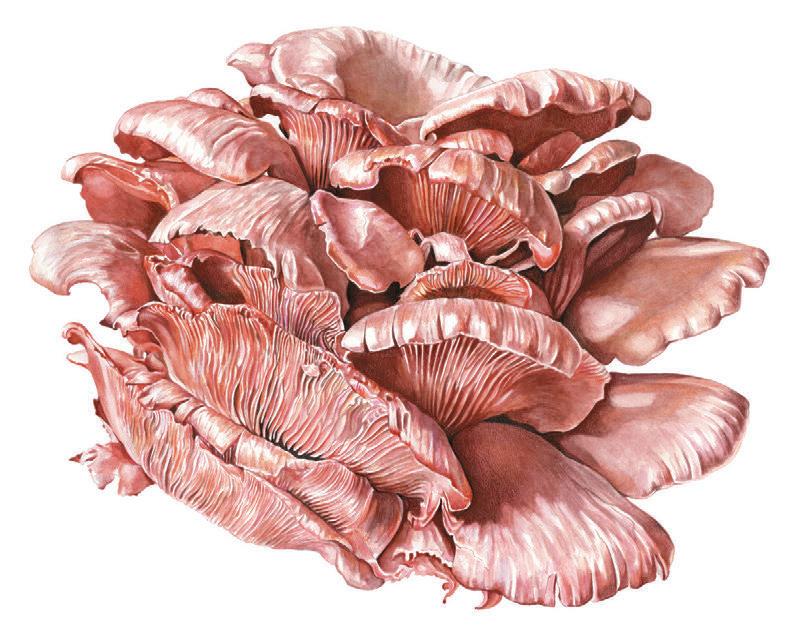
“My process starts with me being inspired.”
—Molly ReederTropical pink oyster mushrooms by Reeder


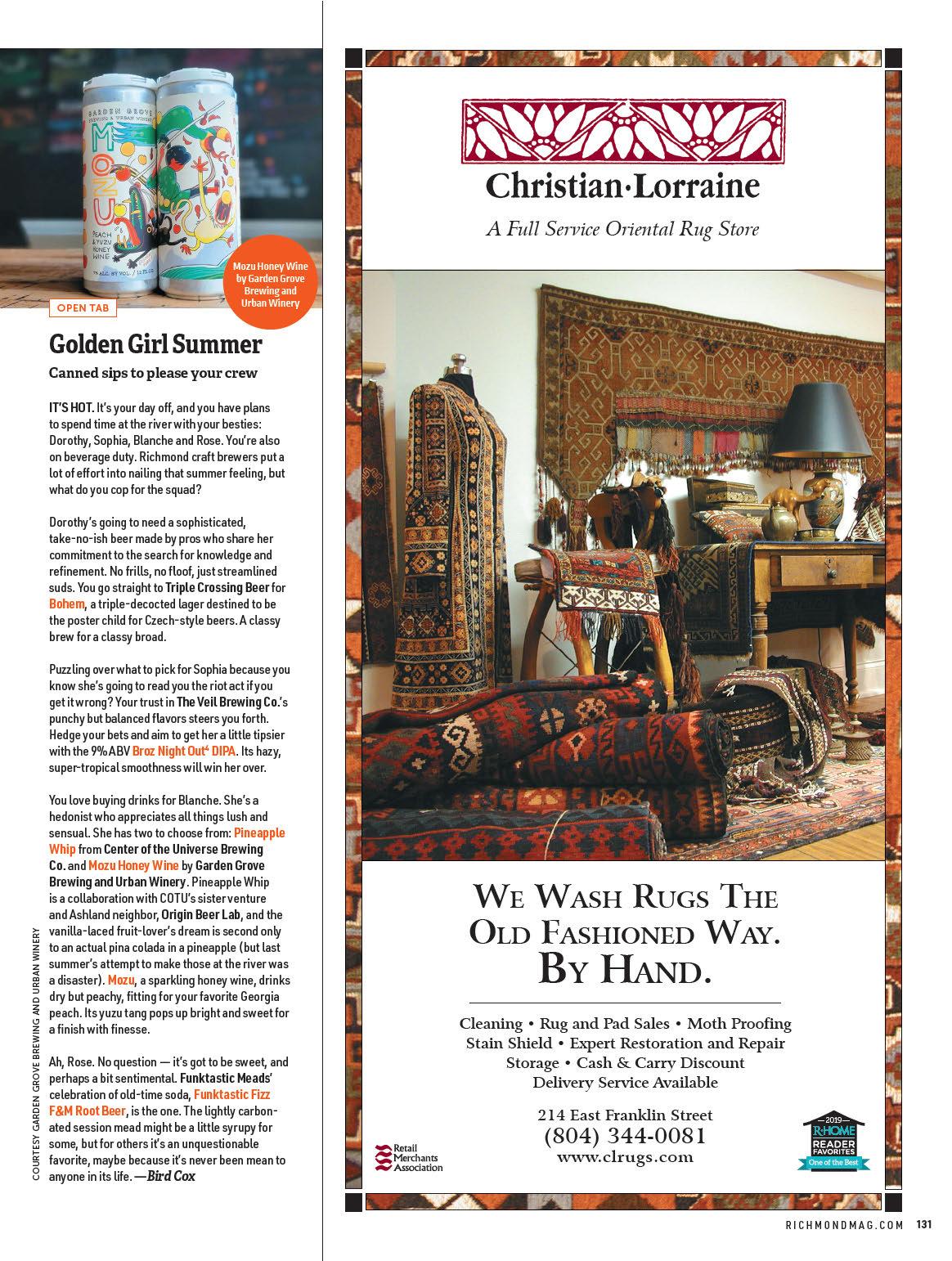
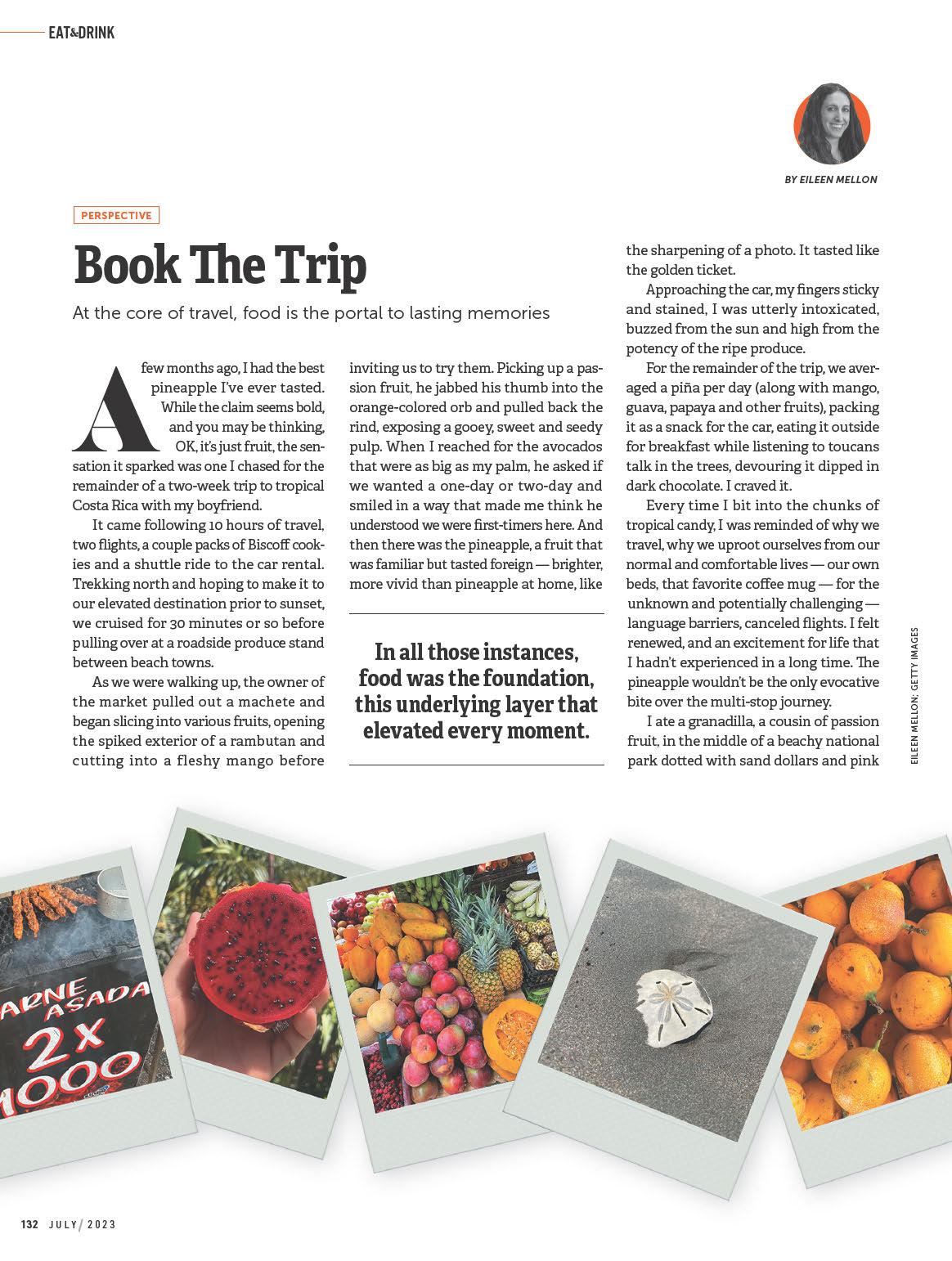
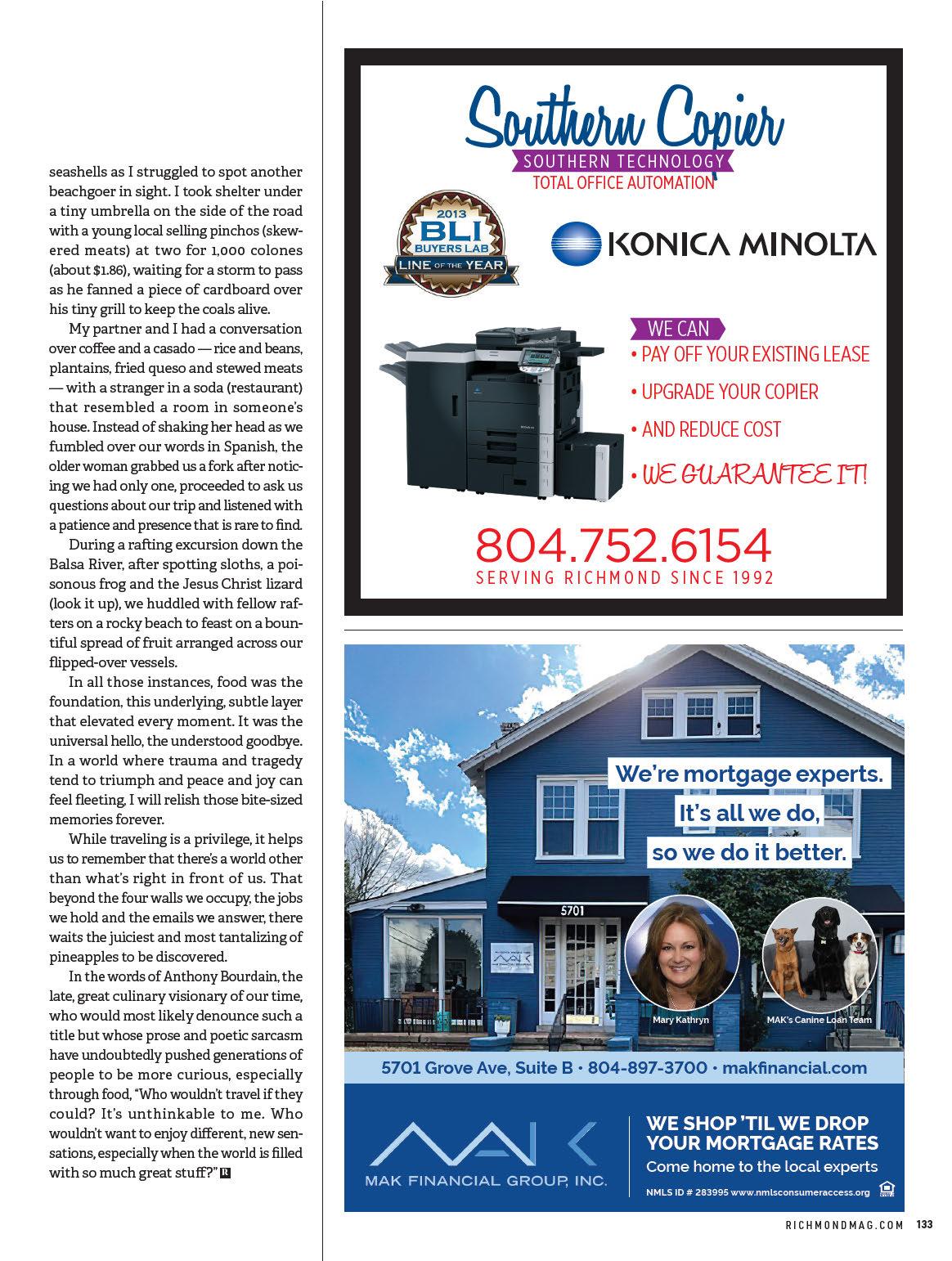


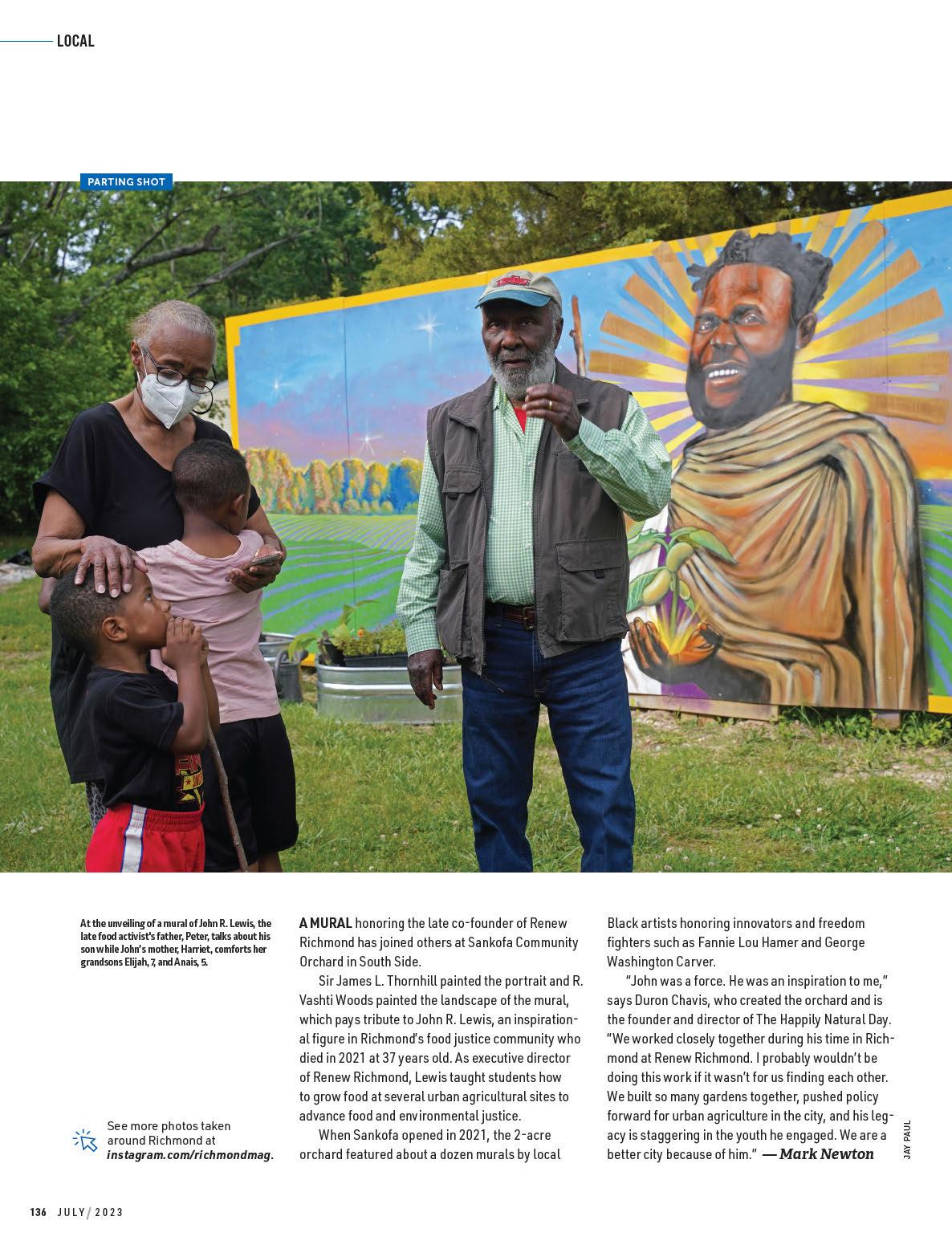













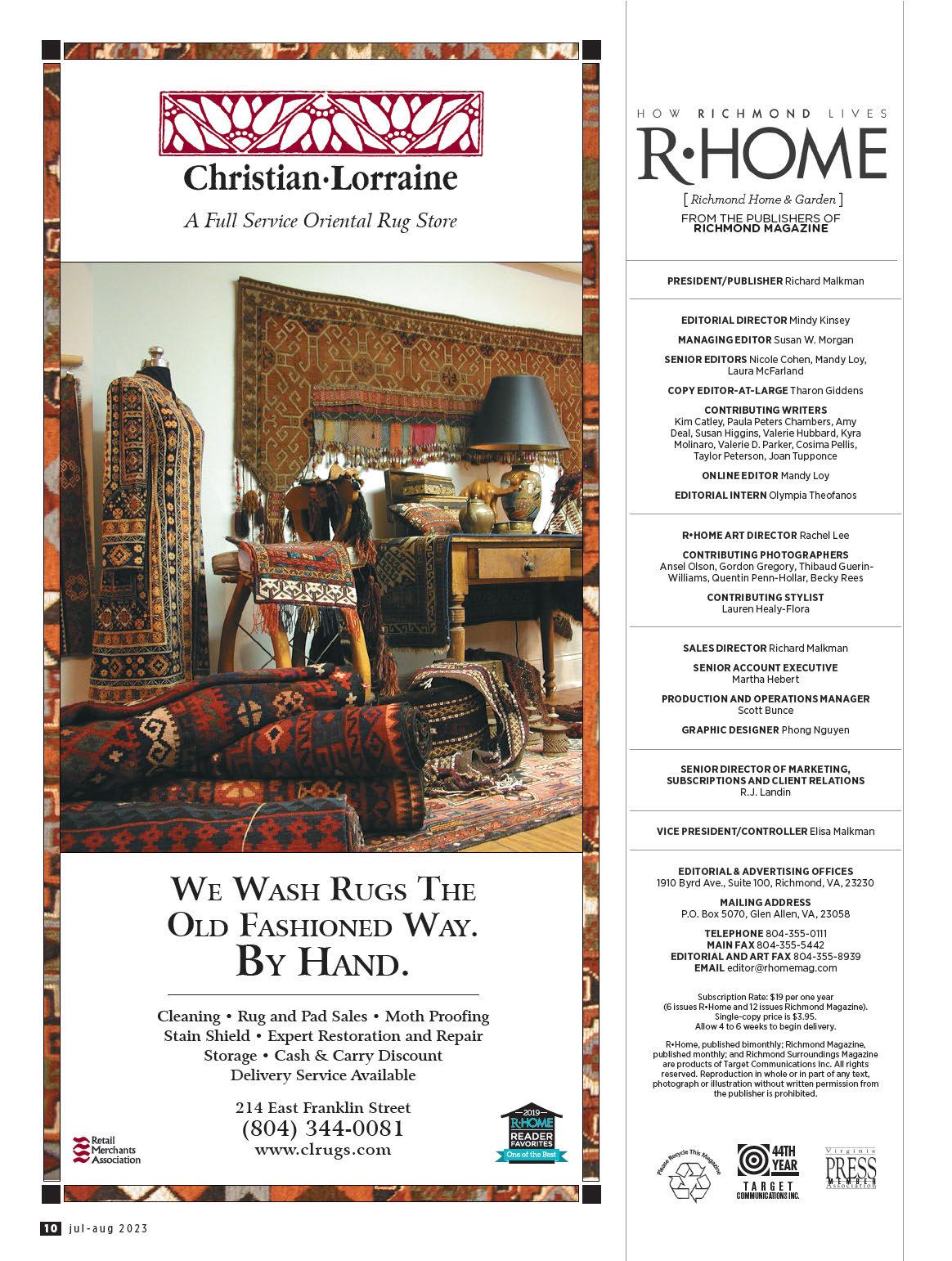


ummertime in Richmond, when the weather is hot. Shade-dappled porches, cool gardens and refreshing pools offer soothing refuges from the summer heat, and indoor-outdoor living is at its finest. Our outside spaces have evolved from simple backyards to al fresco living and dining rooms, places to entertain, places to play, places to unwind.

In this issue, we visit two homeowners, each with distinct personal styles, whose homes were designed to fully embrace indoor-outdoor living. While their aesthetic preferences couldn’t be more different, they share the same goal: to enjoy their homes, inside and out.

When designer Annie Frankfort and her husband, Stuart, decided to relocate from their Fan District home, they chose an older house with character and good bones that provided a blank slate they could make their own. Key to their redesign was a NanaWall that creates a seamless flow between their kitchen and the adjoining deck. Kim Catley takes us on a tour on Page 36.

Mitesh and Neema Amin believe one’s home should be a retreat. Their new house is a minimalist’s dream, with soaring ceilings, walls of windows and balconies that overlook the pool and lounging areas. Join Paula Peters Chambers on Page 44 for a conversation with Neema and a look at their spectacular family refuge.
Outbuildings make several appearances in this issue. Valerie Hubbard shows us five new or newly improved structures beginning on Page 30. We also check out the evolution of a dilapidated garage into an Airbnb-ready carriage house on Page 28 and a cool man cave on Page 64.
There are myriad ways to shape our outside environments. We talk outdoor furnishings with Summer Classics owner Traci Lantzy on Page 24, tour the DIY garden retreat Ken Peterson created for his family on Page 56, and look at a newly expanded outdoor living and dining area created by Rock Creek Innovations on Page 54.
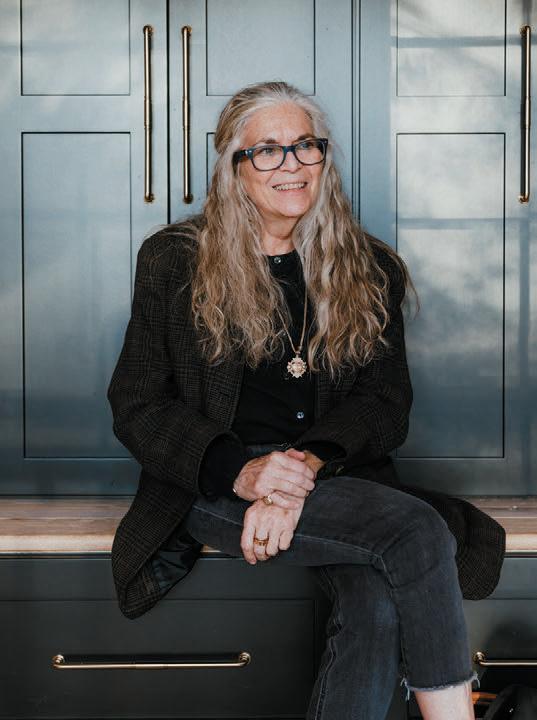













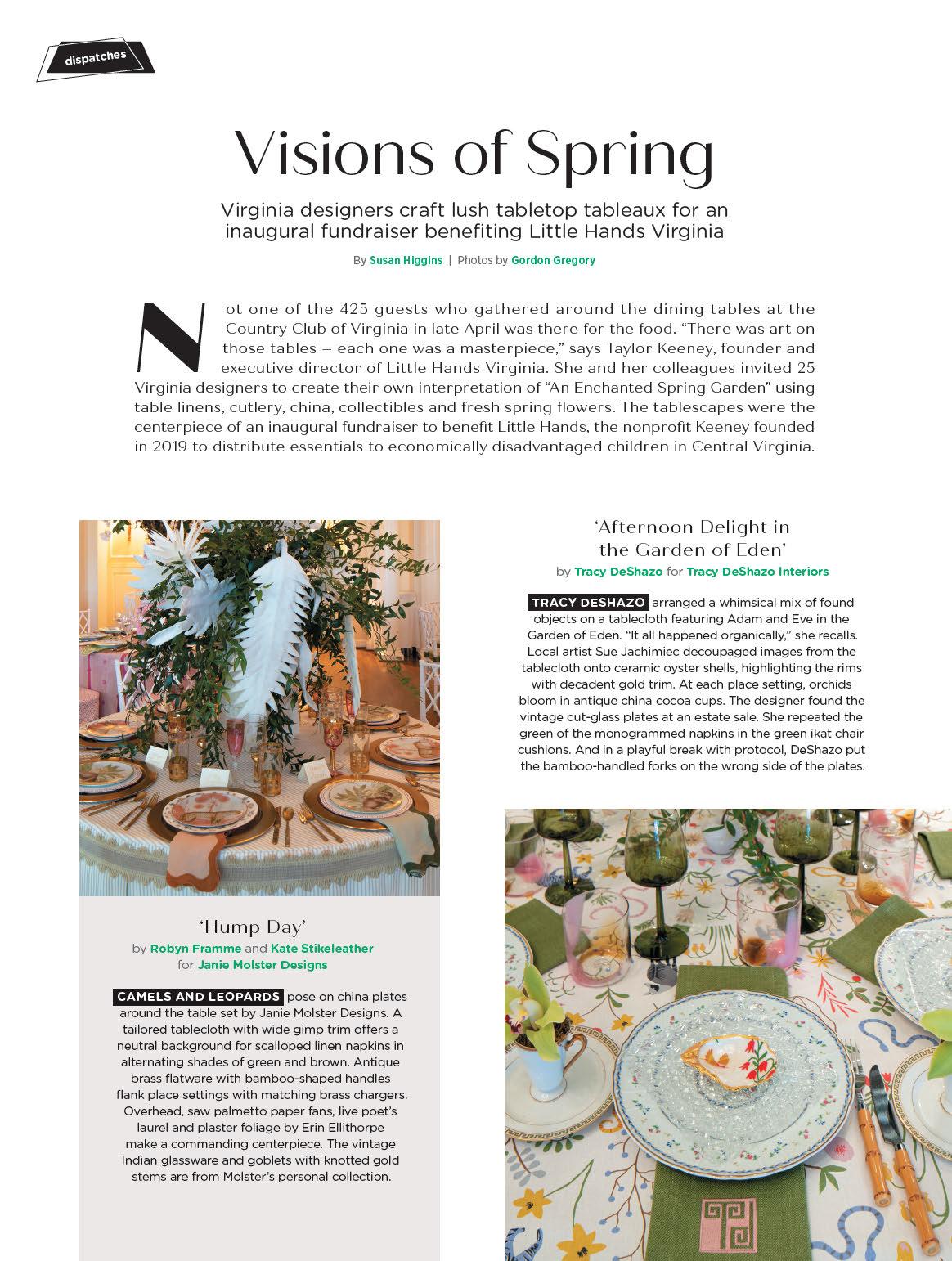



5 new (or newly improved) outbuilding projects
 by VALERIE HUBBARD
by VALERIE HUBBARD


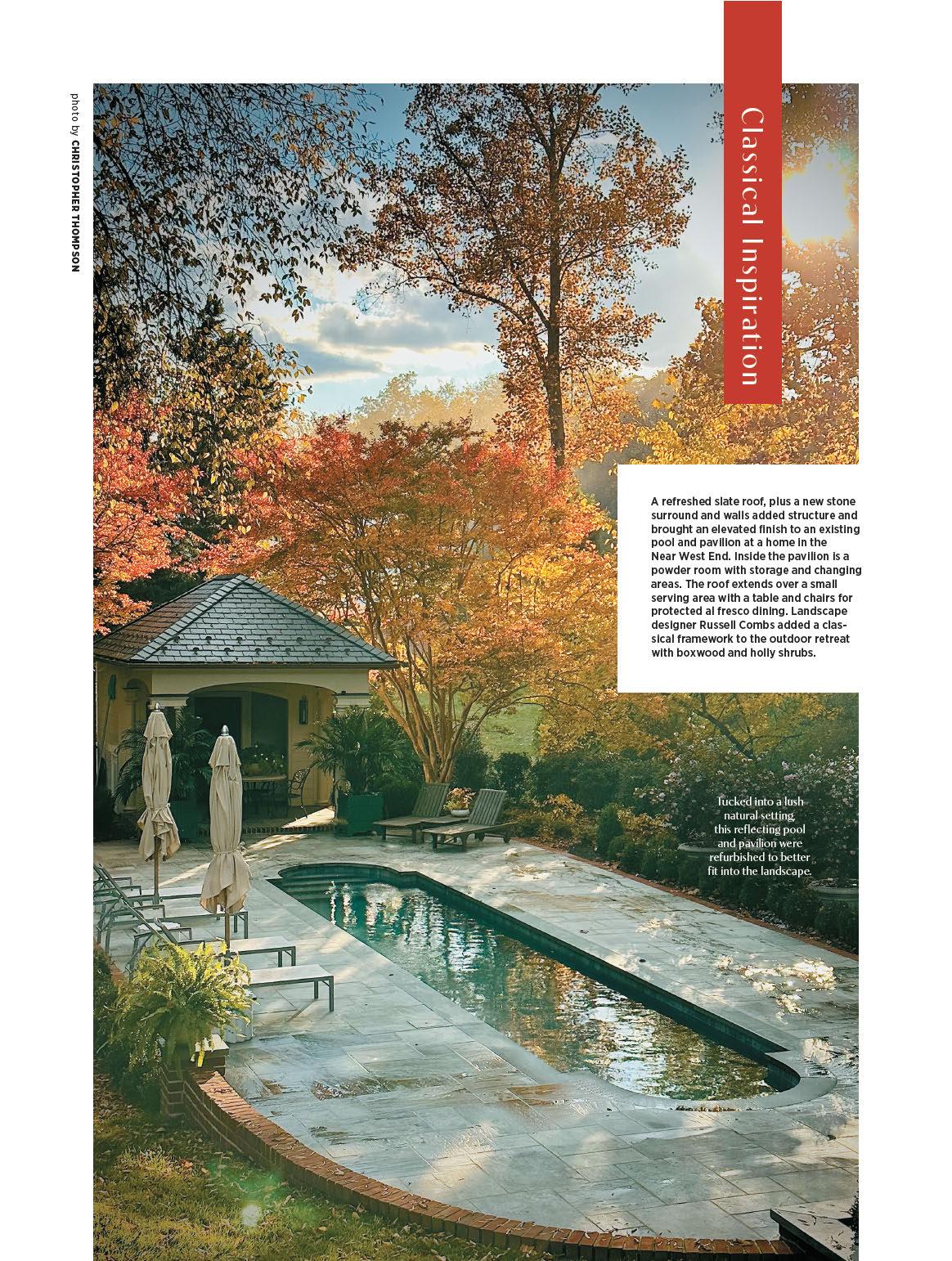


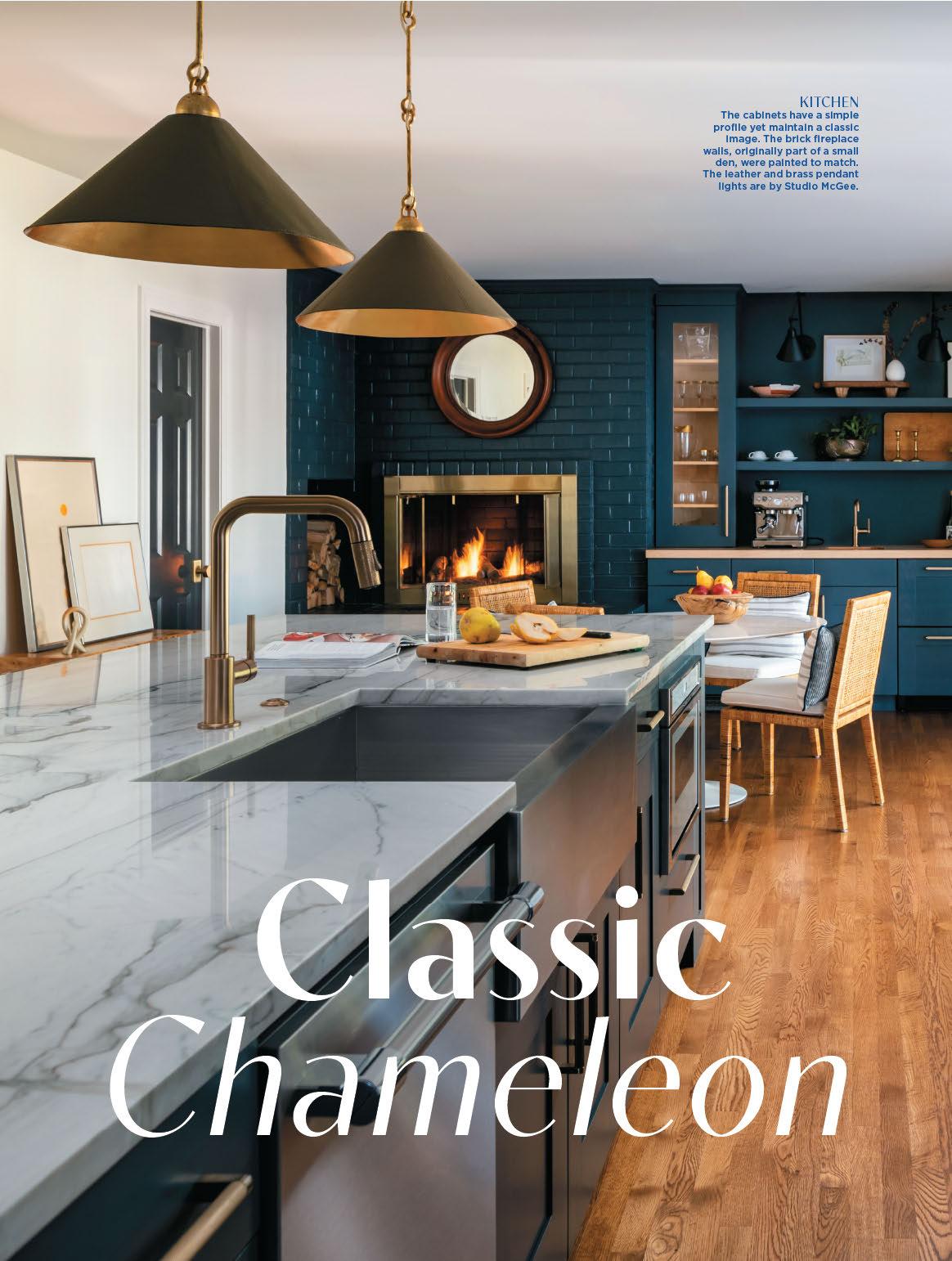



Frankfort says they rescued the antique workbench — which once belonged to her great-grandparents — from its moldy state after discovering it in a shed at her parents’ house.








BAR
Minimal Eurofase Navade LED pendants illuminate the bar without blocking screen views. The painting is by local artist Abernathy Bland, who provided murals in the family’s prior home.

Sconces from Kuzco Lighting and an LED floor strip give glow where it’s needed. Leather swivel chairs are from the RH Italian Shelter line, and the RH Cloud sofa is covered in Lustrous Velvet fabric.

A mural by local artist Mickael Broth, aka The Night Owl, adorns a support column just outside the regulation-size squash court. A window on the upper level o ers spectators a bird’s-eye view.
A compelling online image inspired the design for the inset skylight waterfall feature in the oversized primary shower, which is surfaced in slipresistant body porcelain tile.
Opening to its own private deck, the primary bedroom features an RH Oak Brûlé Live-Edge Platform Bed with West Elm bedding. Ceramic planters bring greenery inside while maintaining a natural theme.

is dedicated to the primary suite. The lowest level is all about fun: a regulation-size squash court hosts matches betw een Mitesh and the children, while a movie theater is perfect for film screenings with family or friends.
The family was able to transfer much of their furniture to their new home and decided to use SherwinWilliams Pure White for most of the walls, with accent colors in muted, natural tones. “It has this feeling of being modern and also earthy, cozy and organic,” Neema says.
Wood, stone, metal and glass also figure prominently. Generous windows throughout are edged in black metal,
as are glass railings. Floors are both wood and stone, flowing seamlessly one into the other. Vertical dark wood slats delineate the entry and dining spaces, and highlight the 24-foot ceiling in the family room. Stone planters and pottery break up expanses of wall and adorn wood shelves.
In the upstairs lounge, a slate wall behind the bar was treated with resin that was then peeled o , creating an irregular finish that gives the impression of clouds floating across the surface. Standing in front of the wall is an equally bold 8-foot bronze island, with a shiny polished brass finish. In the dining room, the chandelier’s brass finial matches the chair legs, which o set the table’s darker bronze pedestal.
Designer Melissa Molitor, who worked with Neema in the design process and helped to select lighting
and fixtures, says the mix supports the home’s natural theme. “This house is about textures and layers,” she says. “We wanted to use textured accents to stop you and let you rest, so it’s not all white. It’s a clean palette and feels so calm.”

Additional visual interest is found in woven chandeliers, especially those above the dining room and kitchen tables, that present as airy architectural elements. Plush throws and pillows on chairs and sofas throughout the house encourage lounging and casual living.
“Our kids really loved our old home, but they’re happy here, in a neighborhood with friends from school,” Neema says. “Once our children are out [of the house], we can live in a condo with maintenance-free living. But if we’re ever going to build a dream home, it should be when they’re living in it.”










 By Susan W. Morgan
By Susan W. Morgan
Quiet luxury, a trend in fashion, fine jewelry and interior design today, is nothing new. It’s all about classic silhouettes made of the finest materials, maintaining a low profile. The late Rachel Lowe Lambert, aka Bunny, Mellon, a master of the style, could have written the book on it. The noted horticulturalist, philanthropist, gardener and art collector was guided by the mantra that “nothing should be noticed.”
Although Mellon, who died in 2014, ran in the highest echelons of society, she was an intensely private person. When Sotheby’s auctioned her legendary collections — art, furniture, jewelry, antique books, etc. — later that year, her grandson, Thomas Lloyd, decided to learn more about the extraordinary woman he knew simply as Granbunny. With the aid of Bryan Hu man, a good friend of his grandmother’s, he delved deep into her world.
“For me, it was really a journey about getting to know her more. Frankly, she was such a private person that, even as her grandson, I really didn’t have a chance to understand more about her other than what most people knew about her publicly. I wanted to really get a better sense of some of her influences, and people and things that were part of her childhood, that shaped who she was,” Lloyd says.
Lloyd and Hu man’s new co ee table book, “Bunny Mellon Style,” introduced in Richmond during Historic Garden Week this spring, not only profiles the major influences in her life, it highlights her immense talents, explores her creative collaborations with couturier Hubert de Givenchy and master jeweler Jean Michel Schlumberger, and gives the reader a glimpse of the rarefied world she created and inhabited.
“Interestingly enough, my grandmother wanted the opportunity to go to college. She approached her father at the time — she had finished up her studies at Foxcroft,
and she wanted to become a set designer for Broadway,” Lloyd says. “She was very creative. And her father sort of knowingly listened but said, ‘You’re not going to college. Here’s a list of available men to marry,’ and … that again is an acknowledgement of the time. But it didn’t deter her when she did marry Paul Mellon ... it created an opportunity for her to showcase not only her own creative skills, but it taught her that she had to learn things on her own.”
Mellon, a gifted gardener who redesigned the White House Rose Garden for President John F. Kennedy and helped to restore Louis XIV’s vegetable garden at Versailles, had a lifelong love of nature and the outdoors, inspired by her grandfather, Arthur Lowe. She studied gardening and landscaping as a girl by shadowing the Olmsted Brothers landscape team overseeing the gardens at her father’s home in Princeton, New Jersey, and studying horticultural tomes.
Her homes were designed with an eye for restraint, Huffman says, recalling that he was struck by the understatement of it all. “You could go in, and there was an unframed Van Gogh [“Green Wheat Fields”] over the fireplace with a slipcovered sofa out of some kind of cotton chintz, with a grass sort of rug and painted floors.”

more relaxation
more exploration
Get away. Relax. Unwind. Disconnect. Re-connect. Have a little more. At Gaylord National, you can have it all this summer.




GaylordNational.com
more connection


LOCAL ACTOR AND GRAPHIC DESIGNER Brian Landis is the creative behind this unique man cave. Formerly a garage, the space is now used for entertaining guests and recording tapes of himself for auditions. Many of the furnishings, such as the paintings and red leather Chesterfield sofa, were thrift store finds. The illuminated sign was a gift from his mother. A stereo system, TV and Danish wood-burning stove add to the chill ambiance. A pair of stained-glass windows mounted on the sides of the sliding doors add interest and hint at the eclectic world within. —Olympia Theofanos


